Term 1 Unit 1 | History | 7th Social Science - Sources of Medieval India | 7th Social Science : History : Term 1 Unit 1 : Sources of Medieval India
Chapter: 7th Social Science : History : Term 1 Unit 1 : Sources of Medieval India
Sources of Medieval India
HISTORY
Unit -1
Sources of Medieval India

Learning Objectives
To
acquaint ourselves with
•
Sources of the study of medieval India
•
Temples, mosques, tombs, palaces and forts as important sources
•
Literary and inscriptional texts
•
Accounts of Arab and Turkish travellers
Introduction:
The
periods from A.D. (CE) 700 to 1200 and from A.D. (CE) 1200 to 1700 are
classified as Early Medieval and Later Medieval periods, respectively, in
Indian history. Numerous and varied sources are fortunately available to the
historians engaging in the study of Medieval India. Added to the information
that can be gleaned from inscriptions, monuments and coins are the accounts
left by Arab, Persian and Turkish chroniclers. These accounts are rich in
detail and have given first-hand information on the life of kings, though they
provide very little information on the life of the common people. The opinions
of the courtiers and chroniclers are often one-sided, written in a hyperbolic
language, exaggerating the king’s achievements. Let us now explore the various
sources available for the study of the history of Medieval India.
Do you know the famous words of Khafi Khan, a courtier of
Emperor Aurangzeb? He says, ‘It is the duty
of an historian to be faithful, to have no hope of profit, no fear of
injury, to show no partiality on one side, or animosity on the other, to know
no difference between friend and stranger, and to write nothing but with
sincerity.’
Sources
Sources
are the supporting materials, documents or records in the form of evidence that
help to reconstruct the past.
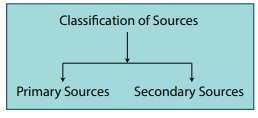
We
examine the details of political, economic and socio-cultural developments with
the aid of sources.
Primary Sources: Inscriptions, monuments and coins, and the
information available in them.
Secondary Sources: Literary works, chronicles, travelogues, biographies
and autobiographies.
Inscriptions
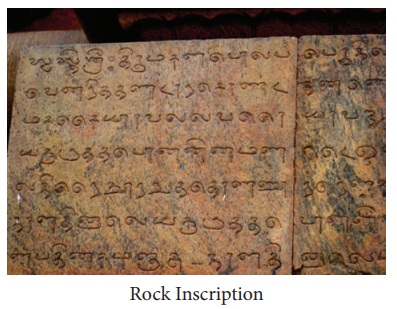
Inscriptions
are writings engraved on solid surfaces such as rocks, stones, temple walls and
metals. The king’s royal decrees, dedications and donations, monuments raised
in commemoration of victories in wars, those built in memory of deceased
warriors, contain rich information about the concerned era.
Various
types of lands gifted by the Chola kings are known from the inscriptions and
copper plates. They are:
Vellanvagai - land of non-brahmin proprietors
Brahmadeya - land gifted to Brahmins
Shalabhoga - land for the maintenance of a school
Devadana - land gift ed to temples
Pallichchandam - land donated to Jaina institutions
Copper-plate
grants, which were treated as legal documents, have significant source value.
The Islamic-Persian practices and the relatively high cost of copper plates
made palm leaf and paper cheaper alternatives from 13th century onwards.
Several
copper-plate grants issued during the later Chola period (10th to 13th century)
record gifts to individual priests or teachers who were Hindu, Buddhist, or
Jaina, or to persons of eminence. Both the giver and the receiver are very elaborately
described. By contrast, most stone inscriptions differ in their content. In
stone inscriptions, the beneficence of a donor is recorded. The major focus is
upon the giver. Tiruvalangadu plates of Rajendra Chola I and the Anbil plates
of Sundara Chola are notable examples. Uttiramerur inscriptions in Kanchipuram
district provide details of the way in which the village administration was
conducted.

Monuments
Temples,
palaces, mosques, tombs, forts, minars and minarets are called by the
collective name monuments.
The
Sultans of Delhi introduced a new type of architecture. The monuments they
built had arches, domes and minarets as the main features. The inscriptions in
these monuments contain rich information, which can be used to construct
history.
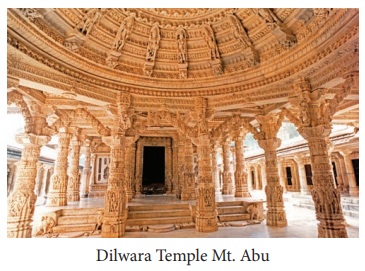
The
medieval Khajuraho monuments (Madhya Pradesh) and temples in Konark (Odisha)
and Dilwara (Mt.Abu, Rajastan) constitute valuable sources to understand the
religion-centered cultural evolution in northern India. Temples in Thanjavur
(Brihadeshwara), Gangaikonda Cholapuram and Darasuram symbolise the magnificent
structures the Later Cholas built in Tamil Nadu. Vitala and Virupaksha temples
at Hampi similarly speak of the contribution of Vijayanagara rulers (15th
century).
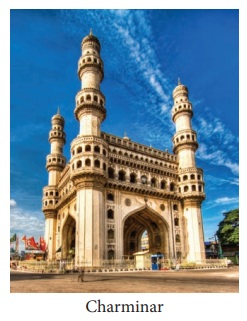
Quwwat-ul
Islam Masjid, Moth-ki-Masjid, Jama Masjid, Fatehpur Sikri Dargah (all in and around Delhi) and Charminar
(Hyderabad) are the important mosques belonging to the medieval times.
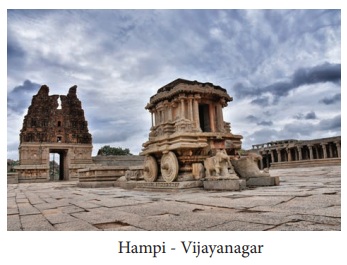
The
forts of historical importance are Agra Fort, Chittor Fort, Gwalior Fort and
Delhi Red Fort as well as the forts of Daulatabad (Aurangabad) and Firoz Shah
Kotla (Delhi). Palaces in Jaipur, Jaisalmer and Jodhpur signify the greatness
of the Rajput dynasty that wielded enormous power from these places. Qutb Minar
and Alai-Darwaza, the tombs of Iltutmish, Balban and all the Mughal rulers are
the other prominent structures recognised as valuable sources of information.
Cities in ruin such as Firozabad and Tughlaqabad in north India and Hampi in
south India remain rich repositories of the history of medieval India.
Coins
The
picture and the legend on the coins convey the names of kings with their titles
and portraits, events, places, dates, dynasties and logos. The composition of
metals in the coins gives us information on the economic condition of the
empire. Mention of king’s achievements like military conquests, territorial
expansion, trade links and religious faith can also be found in the coins.
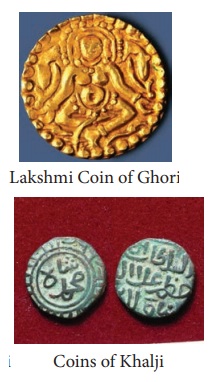
Muhammad
Ghori had stamped the figure of Goddess Lakshmi on his gold coins and had his
name inscribed on it. This coin tells us that this early Turkish invader was in
all likelihood liberal in religious outlook.
Copper
Jitals are available for the study of the period of the Delhi Sultans. Silver
Tanka introduced by Iltutmish, Ala-ud-din Khalji’s gold coins,
Muhammad-bin-Tughluq’s copper token currency are indicative of coinage
as well as the economic prosperity or otherwise of the country of the
time.
A jital contained 3.6
grains of silver. Forty- eight jitals were equal to 1 silver tanka.
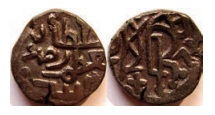
Religious Literature
Devotional
movement in South India and later in North resulted in the development of
bhakti or devotional literature. The Chola period was known as the period of
devotional literature and works such as KambaRamayanam, Sekkizhar’s Periyapuranam,
Nalayira Divyaprabhandham, composed by 12 Azhwars and compiled by
Nathamuni, Devaram
composed
by Appar, Sambandar and Sundarar and compiled by Nambiyandar Nambi,
Manikkavasakar’s Thiruvasagam, all were scripted during the Chola times.
Jayadeva’s Gita Govindam (12th century) was a follow-up of the
Bhakti Movement in South India. Kabir Das, a 15th century mystic poet, also had
an influence on the Bhakti Movement in India.
Secular Literature
Madura
Vijayam and Amuktamalyatha were poems composed by Gangadevi
and Krishnadevaraya respectively that help us gain insight into the events and
individuals associated with the Vijayanagara Empire. Chand Bardai’s Prithiviraj
Raso portrays the Rajput king’s valour. We have no Indian accounts
about what happened during the Turkish invasion of India. For pre-Islamic
periods, the only exception was Kalhana’s Rajtarangini (11th century).
Books, Biographies and
Autobiographies
Minhaj-us-Siraj,
patronised by Sultan Nazir-ud-din Mahmud of Slave Dynasty, wrote Tabakat-i-Nasiri.
The compendium deals with the period from the conquest of Muhammad Ghori
to A.D. (CE) 1260. The compendium was named after his patron. In the 13th
century, Hasan Nizami, a migrant from Ghazni wrote. Taj-ul-Ma’asir towards
the end of Iltutmish’s rule. It provides information about Qutb-ud-din
Aibak and is considered the first official history of the Delhi Sultanate.
Zia-ud-Barni, a courtier of Muhammad Tughluq, wrote Tarikh-i-Firoz Shahi, in
which he dealt with the history of Delhi Sultanate from Ghiyas-ud-din
Balban to the early years of the reign of Firoz Shah Tughluq. Ferishta’sTarikh-i-Frishta
(16th century) deals with the history of the rise of the Mughal power in India.
Tabakat is an Arabic word
meaning generations or centuries. Tuzk is a Persian word meaning autobiography.
Tarikh or Tahquiq are Arabic words meaning history.
In
the 16th century, emperor Babur’s Babur Nama and Abul Fazal’s
Ain-i-Akbari and Akbar Nama provided detailed information about
these two emperors. In the 17th century, Jahangir wrote his memoir, Tuzk-i-Jahangiri,
throwing a lot of light on the period. Apart from autobiographies of emperors, Tabakat-i-Akbari,
authored by Nizam-ud-din Ahmad, is considered reliable than the
exaggerated account of Abul Fazal. Similarly, Badauni’s outstanding work, Tarikh-i-Badauni
(Badauni's History), was published in 1595. This work spans three volumes. The
volume on Akbar’s reign is a frank and critical account of Akbar's
administration, particularly of his religious policy.
Travellers and
Travelogues
Marco
Polo, a Venetian traveller, visited when the Pandya kingdom was becoming the
leading Tamil power in the 13th century. Marco Polo was twice in Kayal, which
was a port city (presently in Thoothukudi district of Tamilnadu). It was full
of ships from Arabia and China. Marco Polo tells us that he himself came by a
ship from China. According to Marco Polo, thousands of horses were imported
into southern India by sea from Arabia and Persia.
Al-Beruni
(11th century) accompanied Mahmud of Ghazni in one of his campaigns, and stayed
in India for 10 years. The most accurate
account
of Mahmud’s Somnath expedition is that of Alberuni. As learned man and a
scholar, he travelled all over India trying to understand India and her people.
He learnt Sanskrit and studied the philosophy of India. In his book Tahquiq-i-Hind,
Alberuni discussed the Indian conditions, systems of knowledge,
social norms and religion.
Ibn
Battuta (14th century), an Arab-born Morocco scholar, travelled from Morocco
right across North Africa to Egypt and then to Central Asia and India. His
travelogue (Rihla [The Travels]) contains rich details about the
people and the countries he visited. According to him, Egypt was rich then,
because of the whole of the Indian trade with the West passed through it. Ibn
Battuta tells us of caste in India and the practice of sati. We learn
from him that Indian merchants were carrying on a brisk trade in foreign ports
and Indian ships in the seas. He describes the city of Delhi a vast and
magnificent city. Those were the days when Sultan Muhammad bin Tughluq
transferred his capital from Delhi to Devagiri (Daulatabad) in the south,
converting this city into a desert.

In
the South, Vijayanagar had many foreign visitors who left behind their detailed
accounts of the state. An Italian named Nicolo Conti came in 1420. Abdur-Razzaq
came from Heart (the court of Great Khan in Central Asia) in 1443. Domingo
Paes, a Portuguese traveller, visited the city in 1522. All of them recorded
their observations, which are very useful for us today to know the glory of the
Vijayanagar Empire.
Summary
•
The period from A.D. (CE) 700 to 1200 and from A.D. (CE) 1200 to 1700 are
classified as Early Medieval and Later Medieval periods in Indian history.
•
Sources are classified as primary and secondary sources.
•
Inscriptions on stones, rocks and temple walls and copper-plate grants with
royal orders and events in the courts, which have evidentiary value are dealt
with.
•
Temples, palaces, mosques, tombs, forts, minars and minarets, collectively
known as monuments, belonging to early Medieval and Mughal periods, are
highlighted.
•
The coins of Iltutmish, Ala-ud-din Khalji and copper coins of the later Islamic
rulers are discussed.
•
Devotional literature belonging to the era of Bhakthi Movement is provided.
•
Books, biographies and autobiographies that provide information about the
political, social and economic conditions of the medieval times are detailed.
• Travallers’ accounts mostly by the visiting Arab and Persian scholars are given in the end.
Glossary
1.
chronicler: a person who writes
accounts of important historical events வரலாற்றுப் பதிவாளர்
2.
animosity: hostility, antagonism விரோதம், பகைமை
3.
travelogue: a book or
illustrated account of the places visited and experiences encountered by a
traveller பயணக்குறிப்புகள்
4.
commemoration: in
remembrance of நினைவாக
5.
elaborately: in detail விரிவாக
6.
minarets: a tall tower,
typically part of a mosque தூபிகள்
7.
repositories: the
places, buildings where materials are stored or kept களஞ்சியங்கள்
8.
portraits: pictures , images in
drawing or painting உருவப்படங்கள்
9.
compendium: a collection
of detailed information about a particular subject , especially in a book தொகுப்பு
10.
substantiate: to prove
with evidence சான்றுகளுடன் நிரூபித்தல்
References
1. Abraham Eraly, The Age of Wrath,
New Delhi:Penguin Group, 2014.
2. Burton Stein, A History of India,
New Delhi: Oxford University Press, 2004 (Reprint).
3. K.A. Neelankanta Shastri, Cholas.
Madras: University of Madras (Reprint).
4. S.K. Singh, History of Medieval
India. New Delhi: Axis Books Private Ltd, 2013.
ICT CORNER
Sourc es of Medieval India
This activity helps you to know about
the rare collection of coins.

PROCEDURE :
Step 1: Open the Browser and type the
given URL (or) Scan the QR Code.
Step 2: Click “India ” Option and then
select any period (Ex. Medieval)
Step 3: Select any dynasty and then
select any Kingdom (Ex. Sultanate)
Step 4: Explore the coins with
pictorial descriptions.
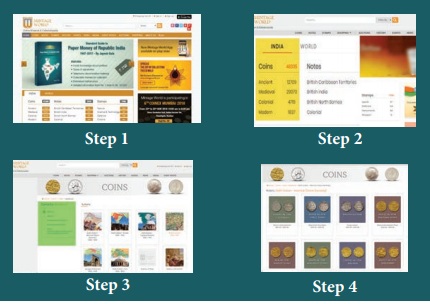
Sources
of Medieval India URL:
https://www.mintageworld.com/
(or) scan the QR Code
*Pictures
are indicative only
*If
browser requires, allow Flash Player or Java Script to load the page.
Related Topics